Operating principles of capacitance level switches and application examples
As well as for measuring levels, our capacitance level switch has been used in various other applications..
Conventional capacitance sensors only measure liquid levels. However, our capacitance level equipment can be used for a number of applications.
This page introduces the operating principles of capacitance level meters and shows some application examples. If you are saying, We need a level sensor that can measure in our specific conditions, then count on us. We can provide devices that will meet any need, including the following.
Operating principles of capacitance level switch
Application example・measure liquid levels continuously without contact
Application example・detecting levels in small tanks.
Application example・measure bubble levels
Application example・measuring an emulsion of oil and water
Operating principles of capacitance level switch
An electrode (sensor) has two poles: a detection electrode and grounded electrode. The meter detects the capacitance and conductivity between the two electrodes.
An amplifier connected to the electrodes reports the amount of material and its status.
Advantages of capacitance type
- The sensor can detect almost all forms of substances, including liquids and powders, as well as both conductive and insulating materials.
- Not affected by temperature, pressure, or dust.
- There are a wide variety of electrodes to allow the detection of different forms and materials. You can select from various models to match your conditions.
- No moving parts and excellent durability.
Application example・Non contact continuous level measurement of liquid
- We manufacture liquid dosing systems. We want to measure the level of a liquid continuously in a glass tube that is 1 cm in diameter.At present, we are measuring the liquid levels by installing several non-contact optical switches on a glass tube. Is there a device that can measure the liquid level continuously with only one sensor?
-
There has been no way to measure the liquid level in the glass tube continuously except to install several compact capacitance or optical level switches directly on the glass tube. (See figures A & B below.)
Combining our converter for level control equipment and electrodes for monitoring a glass tube will allow you to measure the liquid level in glass and plastic tubes without contact. (See figure C.)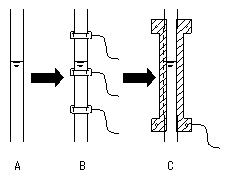
Some liquid tanks are equipped with level gauges (glass gauges) on their sides that permit visual checks. Some users want to capture the levels electronically, as well as visually. As a way to meet these requirements, we attached a special sensor exclusively designed for level gauges. By using our amplifier for level meters to convert changes in the liquid level (capacitance) in the level gauge, we can output the level change as a continuous stream of electronic signals.
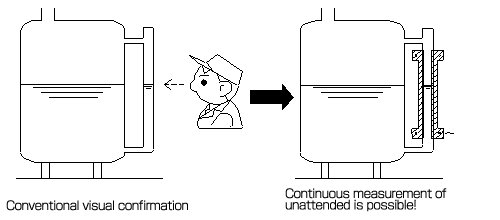
Our amplifier for liquid level monitoring allows us to measure in various situations, including when level measurement in a glass tube is needed, as described above.
However, the precise solution depends on the application environment, so we must make a detailed examination of the environment and the material to be measured. Please feel free to contact us.
Application example・detecting levels in small tanks
- We want to continuously measure the liquid level in a small tank. We are searching for a liquid meter that can be cleaned and can be used in high temperatures and pressures. Is there any liquid meter suitable for these conditions?
-
There are many types of liquid level indicators, including the pressure, float, magnetostrictive, ultrasonic wave, and capacitance types. Each of these has advantages and disadvantages. We must select a liquid level gauge carefully when it will be used in a harsh environment. In response to your request for a cleanable one, we recommend our MXL liquid level meter.
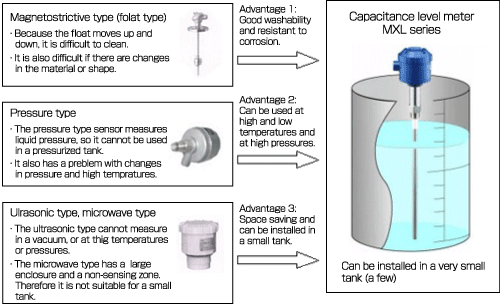
To check the material to be measured
Capacitance level meters can measure almost all materials. However, there are some they cannot measure due to the specific capacitance of these materials. Please contact our Sales Dept. to learn what materials can be measured.
Application example・measure bubble levels
- Q. Measuring the levels of liquids and powder is common. How about to measure the level of bubbles?
-
A. Few years before, a staff in a plant of large manufacturing company inquired us, We want to measure thickness and level of bubbles generated by chemical reaction on production processes. Is there any meter for this purpose?
We examined the idea and proposed a capacitance level measuring system.
After our capacitance level meter was installed in the tank, the meter detected foam non-stop and solved the problem.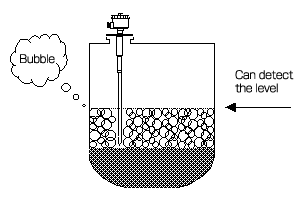
Application example・measuring an emulsion of oil and water
- Q. What are some cases of measurements you’ve experienced where you applied capacitance sensors?
-
A.We have a sensor to measure moisture content in oil in our product line. This time, we introduce a case of measuring emulsion of oil and water as a special case. to emulsify, water is added to oil in a tank show in the lower left, and agitated. On the way to mixing oil with water, they separate as time elapse. Therefore, they have to operate agitator excessively.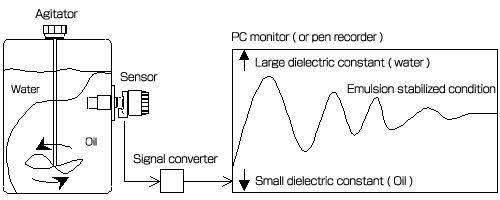
Principle of capacitance
Any substance has its own unique dielectric constant. Dielectric constant of water is 80 and one of oil is merely 2 to 3. The capacitance sensor captures increase of water and oil volumes (in proportion to increase of dielectric constant) as increase of capacitances and outputs detection signals.
Description of the measurement
First, oil and water are separated each other. By agitating, emulsion particle sizes become smaller by agitation and finally becomes completely emulsified. By agitating, oil and water pass around the sensor alternately. As emulsion is advancing, change width (water dielectric constant is 80 and oil is 2 to 3) of output signal of dielectric constant is becoming smaller and smaller as shown in the screen at the upper right, and current emulsified status is measured. By this monitoring, we can judge whether we can stop agitation or nor.
Precaution:
This case is special measurement example. This system may not precisely measure the emulsion status depending on the of material to mix (when conductive material is contained9 and status of material. Please contact us for preliminary examination.












